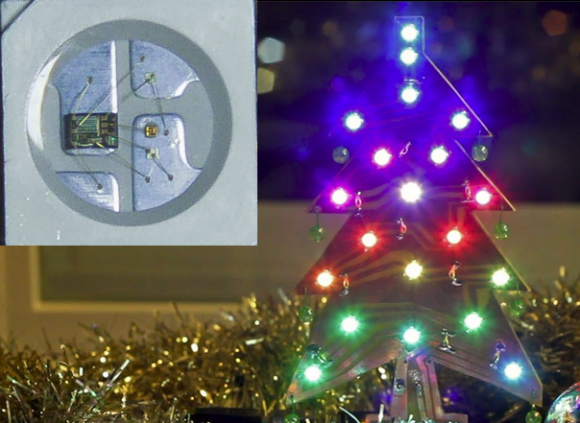
Nothing reminds us that it’s the holiday season more than an LED Christmas Tree submission. This obviously is not the first of its kind, but [Jose] does offer up a new technique using addressable RGB LEDs.
[Jose] decided to use 20 WS2812B RGB LEDs, which if you haven’t seen before, are RGB LEDs with an integrated controller. Yep, that’s right, just power/ground and 1 data line is all that is needed to control hundreds of RGB LEDs. This LED tree’s design is simple: a custom-etched PCB cut it in to the shape of a Christmas tree. The WS2812B LEDs helped keep everything clean, so the tree lacks any ‘ugly’ ornaments, except for the required bypass cap here and there. For an added bonus, the tree’s LEDs are synchronized to music generated by an Arduino via a piezo buzzer. Why is it a shield? Well, the whole tree plugs in nicely to a standard Arduino interface. This looks like the perfect starter project to familiarize yourself with addressable LEDs, or at least to get you warmed up before building your own infinity portal.















“For an added bonus… music generated by an Arduino via a piezo buzzer”
Curious use of “bonus” there.
Okay, I understand your curiosity. I guess it was just a little bonus for me, since I originally watched the video muted. After reading through the project, I noticed the piezo, so I re-watched with sound, and then got my ‘bonus’. What can I say, I’m a sucker for synchronized LEDs to music.
anybody know where to buy the led’s?
A quick search of WS2812B shows all the big players have them; sparkfun, adafruit, etc… Looks like you can get them from Ebay as well.
I usually consider the big players to be the likes of Digikey, Mouser, RS, Element14, etc. But curiously enough I don’t see the pixels available from any of those sources.
Am I searching for the wrong thing?
The best place to look is ebay. I found them smoothly.
Your big players are big distributors for the major semiconductor
companies usually gears towards small/medium volumes. You won’t find
consumer electronics components (e.g. TV parts) there as customers that
deal in those volumes would go directly to the manufacturers.
Kevin’s idea of “big” is geared towards hobbyists niche market. They
resells Chinese electronic parts that are profitable and of interest to
their customers.
What’s the difference between these WS2812’s and WS2811 and WS2801 etc?
My understanding of the diff between then WS2812, A, and B is this:
WS2812: 400KHz data, 6-pin
WS2812A: doubles the datarate to 800KHz
WS2812B: drops to 4-pin (PLCC4?)
There is still an advantage to using the A version though, as I found in my current project: the LED and logic voltages can be different. Since it wants 5.0V for LED drive, but my microcontroller runs at 3.3V, I can feed 3.3V into VL and get what I need without a level converter.
What I’d love to see somebody make is a 5mm or 8mm version of the WS2812B, which can be “trivially” integrated into “conventional” Christmas-light strings.
Can’t help you with the 2811 or 2801 details though.
The WS2812B is quite happy running on 3.5 V, so you don’t need a level converter.
Doesn’t exactly help when I don’t have 3.5V…
WS2801 and WS2811 are drivers, not leds.
WS2801 has 14 pins, and is 2-Wire (data and clock) .
WS2811 has 8 pins and is 1-Wire.